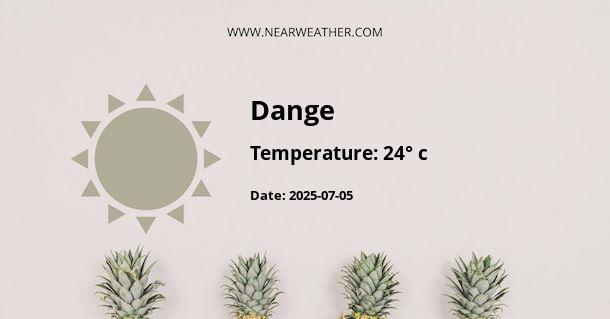Dange, Nigeria: Climate and Weather Year Round
Dange is a local government area located in Sokoto State, Nigeria. Situated in the Northwestern part of the country, Dange experiences a tropical climate characterized by distinct wet and dry seasons. The weather in Dange is influenced by its proximity to the Sahel region and the Nigerian lowland.
Climate in Dange
The climate in Dange can be classified as tropical savanna climate, also known as Aw according to the Köppen climate classification system. This type of climate is characterized by distinct wet and dry seasons throughout the year.
The wet season in Dange typically starts around May and lasts until September. During this period, the region experiences high humidity and frequent rainfall. The average monthly precipitation ranges from 100mm to 250mm, with the highest rainfall occurring in July and August. These months are considered the peak of the rainy season in Dange.
The dry season in Dange usually begins in October and extends until April. This period is characterized by low humidity and little to no rainfall. The harmattan wind, a dry and dusty wind that blows from the Sahara Desert, is common during the dry season. The harmattan wind can bring cooler temperatures and reduced visibility due to the dust particles in the air.
Temperature in Dange
Dange experiences high temperatures throughout the year, with slight variations between the wet and dry seasons. The average annual temperature in Dange is around 30°C (86°F).
During the dry season, temperatures can rise significantly, with daytime temperatures often reaching above 40°C (104°F). The nights are relatively cooler during this period, with temperatures dropping to around 15-20°C (59-68°F).
In contrast, the wet season brings relief from the scorching heat. Daytime temperatures during the rainy season usually range from 25-35°C (77-95°F), with nighttime temperatures averaging around 20-25°C (68-77°F).
Precipitation in Dange
Precipitation in Dange is mainly concentrated in the wet season, with the majority of rainfall occurring between May and September. The average annual rainfall in Dange is approximately 700-900mm.
During the peak of the rainy season, heavy downpours are common, contributing to the overall high precipitation levels. The rain is crucial for agricultural activities in the region, as it supports the growth of crops such as millet, sorghum, and cowpea.
Climate Variability and Effects
Like many regions in Nigeria, Dange has experienced some climate variability and its associated effects. Over the past few decades, there has been a noticeable increase in temperature and changes in rainfall patterns in the area.
These changes have had significant impacts on agriculture, water availability, and overall livelihoods in Dange. Farmers have had to adapt their farming practices and crop choices to cope with the changing climate conditions.
Conclusion
Dange, Nigeria, experiences a tropical savanna climate with distinct wet and dry seasons. The wet season lasts from May to September, characterized by high humidity and significant rainfall. The dry season, from October to April, brings low humidity, minimal rainfall, and the presence of the harmattan wind. The average annual temperature in Dange is around 30°C (86°F), with variations between the seasons. The region receives most of its rainfall during the wet season, with an average annual precipitation of 700-900mm. Climate variability has impacted agriculture and livelihoods in Dange, requiring adaptation strategies to mitigate the effects.
A - Dange's Latitude is 12.851280 & Longitude is 5.347050.
A - Weather in Dange is 18° today.
A - Climate Conditions in Dange shows broken clouds today.
A - Humidity in Dange is 22% today.
A - Wind speed in Dange is 16.06 km/h, flowing at 70° wind direction. today.
